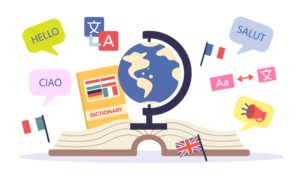Arabic is a widely spoken language with speakers across the world, making translation highly valuable. Many Japanese companies have expanded into the Middle East, a region that has achieved significant economic growth. Moreover, Middle Eastern people tend to be pro-Japan, showing strong interest in Japanese products, traditional culture, fashion, and anime, which further increases the demand for translation.
In Saudi Arabia, it is legally required to provide Arabic manuals for imported products. Even in countries without such regulations, English is not widely spoken in many Middle Eastern nations, making translation essential for effective communication.
The tourism sector is another key area. As Japan's tourism ministry seeks to attract more visitors from the Middle East, various promotional efforts are already underway across the country. With the growing focus on halal-friendly services and prayer accommodations, accurate translation plays a crucial role in delivering the right information.
At NAIway Translation Service, our experienced translators—specialized in various fields—handle a wide range of Arabic translation needs, including:
- Business documents and contracts
- Product manuals and catalogs
- Tourism brochures and guidebooks
- Social media and websites
- Restaurant and café menus
- Manga and anime-related content
With expertise and proven experience, we ensure high-quality translations tailored to your needs.
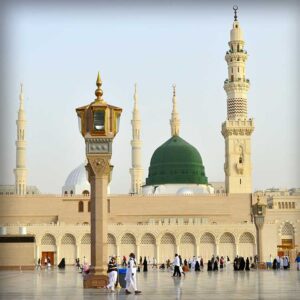
For more details, please feel free to contact us.
Arabic Translation Rates (Japanese-Arabic & Arabic-Japanese)
Below are NAIway’s standard translation rates.
Our regular translation fees cover all of the following services, so you can rely on us with confidence.
Translation
+
Native-Level Quality Check
+
After-Support※
※ As part of our after-support, we handle revisions and inquiries within the post-delivery verification period (typically one week).
(Please note that changes or additions to the original document are not included.)
Japanese to Arabic Translation

From 30.8 JPY per character
Arabic to Japanese Translation

For pricing, please contact us.
- The actual cost will be estimated based on the content and volume of the document. Please send us the document when requesting a quote.
- Minimum Charge Policy. Depending on the character/word count and other conditions, we have a two-tier minimum charge system of 5,500 Japanese Yen or 11,000 Japanese Yen (tax included). This ensures coverage of the essential costs involved in translation coordination and quality assurance.
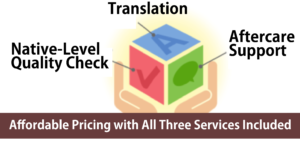
For more details, please feel free to contact us.
NAIway's Quality Assurance System
At NAIway Translation Service, we believe that quality management is our top priority as a professional translation company. To ensure the highest standards, we have developed our own Quality Assurance System (QAS) and implement strict quality control measures.
For high-quality Japanese-Arabic and Arabic-Japanese translations, every document undergoes a two-step review process: after the initial translation, a second translator conducts a thorough quality check.
We meticulously review each character and sentence, ensuring logical flow, terminology consistency, and appropriate expressions to deliver a refined translation tailored to your needs.
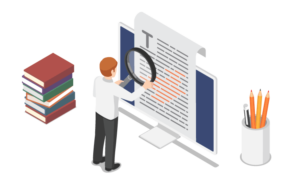
Multilingual Translation Support
At NAIway, we offer multilingual translation services. Along with Arabic, we provide translations in English, Chinese, Thai, Indonesian, and more—all in one place.
If you're considering inbound tourism solutions, feel free to contact us for a consultation!

Introduction to Our Arabic Translators
Here are some of the translators currently working with or registered at NAIway.
For more details, please feel free to contact us.
What is the Arabic language?
Originating in the 4th century CE on the Arabian Peninsula, Arabic spread across North Africa, Iraq, and Syria with the rise of Islam. The Qur’an, written in Arabic, played a crucial role in its expansion, making it one of the most widely spoken languages today.
Arabic has approximately 290 million native speakers, but when including second-language speakers, the number exceeds 400 million, making it the third most spoken language in the world. Due to its significant influence, Arabic is the only language that was later added as an official language of the United Nations.
Modern Arabic is divided into two main forms:
- Fus'ha (Modern Standard Arabic - MSA): A standardized form based on Qur’anic Arabic, used as the official language across Arab countries for formal writing, media, and official communication.
- 'Ammiyah (Colloquial Arabic): Spoken dialects that vary significantly by region.
Arabic learners typically study Fus'ha, as it is the common written form. However, for everyday communication in different Arab countries, learning the local dialect ('Ammiyah) is also necessary.
Arabic has influenced many languages, particularly due to the spread of Islam. Over 4,000 words in Spanish have Arabic origins. Additionally, languages such as Persian, Hindi, Turkish, and Indonesian have also incorporated numerous Arabic loanwords.
The Arabic Script
Arabic uses the Arabic script, which is written horizontally from right to left. However, numbers are written from left to right.
How to Say “Hello” in Arabic
اَلسَّلَامُ عَلَيْكُمْ/æs.sæˈlæː.mu ʕæˈlæj.kum/
Primary Regions of Use
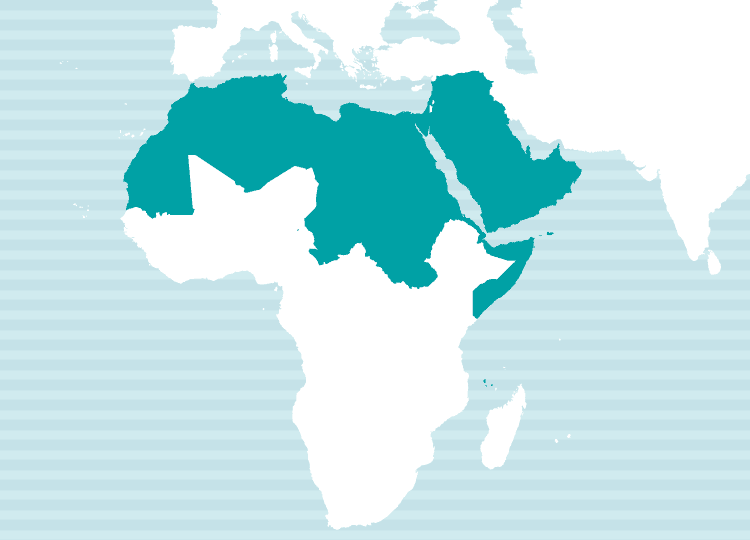
Language Family: Afro-Asiatic → Semitic
Spoken in:
Asia: United Arab Emirates, Yemen, Israel, Iraq, Oman, Qatar, Kuwait, Saudi Arabia, Syria, Bahrain, Palestine, Jordan, Lebanon, and more.
Africa: Algeria, Egypt, Eritrea, Comoros, Djibouti, Sudan, Somalia, Chad, Tunisia, Mauritania, Morocco, Libya, and more.
The Two Forms of Arabic: Fus'ha and 'Ammiyah
Modern Arabic is divided into two main forms:
- Fus'ha (Modern Standard Arabic - MSA)
- This is the formal, standardized form of Arabic, derived from Qur’anic Arabic.
- It is taught in schools but is rarely spoken in daily conversation.
- Fus'ha is used in mosque sermons, academia, newspapers, news broadcasts, and political speeches.
- 'Ammiyah (Colloquial Arabic)
- This refers to the spoken dialects used in everyday conversations.
- Unlike Fus'ha, 'Ammiyah has no standardized orthography and is rarely written.
- Dialects vary so significantly between regions that they can be considered almost different languages.
Major Arabic dialect groups include:
- Gulf Arabic
- Iraqi Arabic
- Syrian Arabic
- Lebanese Arabic
- Palestinian Arabic
- Egyptian Arabic
- Sudanese Arabic
- Maghrebi Arabic (spoken in North Africa)
- Hassaniya Arabic (spoken in Mauritania and parts of the Sahara)
Even within each dialect group, regional variations exist, making Arabic one of the most linguistically diverse languages in the world.
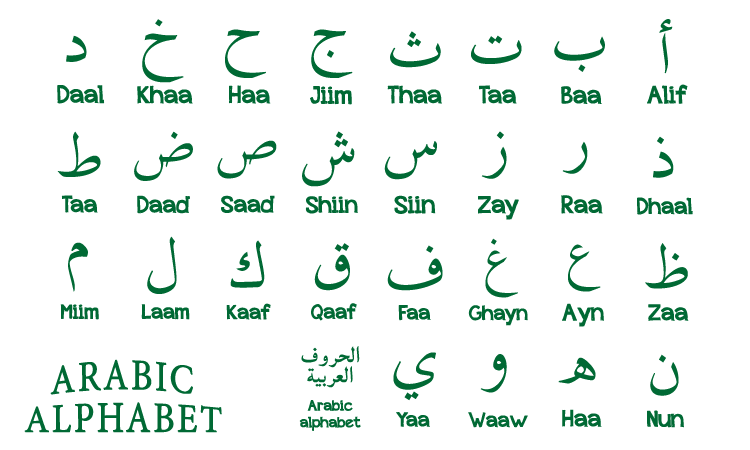
Japanese Words of Arabic Origin
Many words of Arabic origin have traveled across cultures and eventually became part of the Japanese language. One example is "襦袢 (juban)", which comes from the Arabic word "jubba" (a long, front-opening coat). It was introduced to Japan via Portuguese.
Other words that originated from Arabic and later spread to Europe before reaching Japan include:
- Monsoon, Safari, Sahara, Sherbet, Mohair
- Lemon, Lime, Jasmine, Saffron
- Sofa, Harem, Gibbs (plaster cast)
- Sugar, Coffee, Alcohol, Alchemy, Alkali
- Massage, Mattress
Additionally, many star names are of Arabic origin, such as:
- Aldebaran, Altair, Deneb, Fomalhaut, Vega, Rigel
These words showcase the historical influence of Arabic on global languages, including Japanese.
